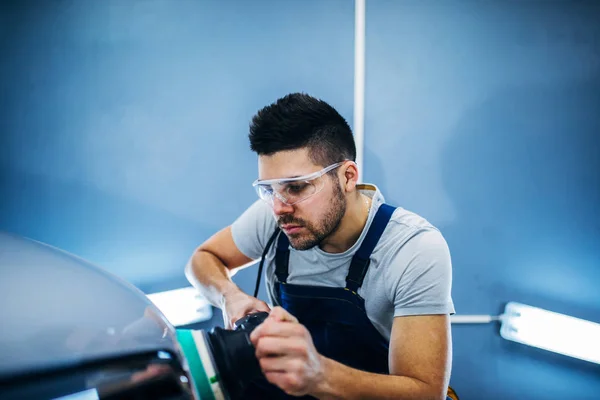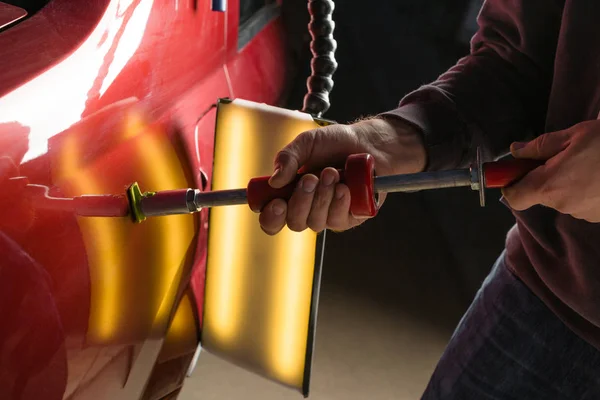The Aesthetics Of Artistry: Transforming Dents Into Masterpieces With Paintless Repair
In the realm of automotive aesthetics, every scratch, dent, or imperfection tells a story. These blemishes can mar the pristine surface of a vehicle, detracting from its overall appeal and leaving owners searching for solutions to restore its former glory. Enter paintless dent repair (PDR), a transformative artistry that seamlessly undoes the damage inflicted on vehicles, turning them into masterpieces once again. In this article, we delve into the world of PDR, exploring its techniques, benefits, and the remarkable skill behind the process.
The Art of Paintless Dent Repair (PDR)
At its core, PDR is a delicate craft that requires precision, patience, and a keen eye for detail. Unlike traditional methods that involve sanding, filling, and repainting damaged areas, PDR works by manipulating the metal from behind the panel, restoring it to its original shape without disturbing the paint. This innovative approach not only preserves the integrity of the vehicle's finish but also offers a quicker and more cost-effective solution compared to conventional repair methods.
The Technique Behind the Transformation
Key points on The Technique Behind the Transformation of paintless dent repair:
- Specialized Tools: Paintless dent repair (PDR) technicians utilize a variety of specialized tools designed specifically for manipulating metal from behind the panel. These tools come in various shapes and sizes to address different types and sizes of dents effectively.
- Precision Manipulation: PDR involves precise manipulation of the metal, achieved through techniques such as pushing, pulling, and tapping. Technicians meticulously work the damaged area, gradually coaxing the metal back into its original shape without disturbing the paint.
- Access Points: A crucial aspect of PDR is gaining access to the backside of the dent. Technicians may remove interior panels, access through existing openings such as door handles or trim, or create access points as needed to reach the damaged area.
- Understanding Metal Properties: Skilled PDR technicians possess a deep understanding of the properties of metal, including its elasticity and memory. This knowledge allows them to predict how the metal will respond to manipulation and adjust their techniques accordingly for optimal results.
- Blend and Feathering: In addition to removing the dent itself, technicians also focus on blending and feathering the surrounding area to ensure a seamless finish. This involves carefully massaging the metal to eliminate any high spots or creases, ensuring that the repaired area matches the rest of the panel perfectly.
- Finishing Touches: Once the dent has been successfully repaired, technicians may apply finishing touches such as polishing or buffing to further enhance the appearance of the panel. These final steps help to restore the vehicle to its original condition, leaving behind a flawless finish that is virtually indistinguishable from the surrounding surface.
These points highlight the meticulous attention to detail and technical expertise required to achieve successful paintless dent repair, making it a preferred choice for restoring vehicles to their former glory.

The Benefits of Paintless Dent Repair
Paintless Dent Repair (PDR) has emerged as a revolutionary technique in the automotive repair industry, offering numerous benefits for vehicle owners. From its non-invasive approach to its cost-effectiveness and environmental friendliness, PDR has become a preferred choice for addressing dents and dings on vehicles of all types. Let's explore in detail the myriad benefits of paintless dent repair:
Preservation of Original Finish
One of the most significant advantages of PDR is its ability to preserve the original factory finish of the vehicle. Unlike traditional repair methods that involve sanding, filling, and repainting, PDR works by manipulating the metal from behind the panel, leaving the paint intact. This means that there is no risk of color mismatch or overspray, resulting in a seamless repair that maintains the aesthetic integrity of the vehicle.
Non-Invasive Repair Process
PDR is a non-invasive repair process that does not require drilling, sanding, or the use of body fillers. Instead, skilled technicians use specialized tools to gently massage the metal back into its original shape, without damaging the paint or underlying structure of the vehicle. This results in a faster, cleaner, and more efficient repair process compared to traditional methods, with minimal disruption to the vehicle's appearance.
Cost-Effectiveness
Another compelling benefit of PDR is its cost-effectiveness. Because PDR does not involve the use of expensive materials such as paint and body fillers, it is often more affordable than traditional repair methods. Additionally, PDR typically takes less time to complete, reducing labor costs and allowing vehicle owners to save both time and money on repairs.

Versatility and Efficiency
PDR is a highly versatile technique that can address a wide range of dents and dings, from small door dings to larger dents caused by hail or minor collisions. Skilled technicians can effectively repair damage on metal panels of varying thickness and curvature, using a combination of pushing, pulling, and tapping techniques. Moreover, because PDR does not require the removal of trim or panels in many cases, it can be completed more efficiently than traditional repairs, minimizing downtime for vehicle owners.
The Artistry of PDR: Transforming Dents into Masterpieces
While PDR is undoubtedly a technical process, it is also an art form in its own right. Behind every successful repair lies the skilled hands of a trained technician who possesses a deep understanding of the nuances of metalwork and a passion for perfection.
Much like a sculptor shaping clay or a painter applying brushstrokes to a canvas, a PDR technician approaches each dent with a blend of precision and creativity. They must visualize the desired outcome and carefully manipulate the metal to achieve it, all while maintaining the integrity of the vehicle's surface.
Moreover, PDR requires a keen eye for detail and a commitment to excellence. A skilled technician will not only remove the dent but also meticulously inspect the surrounding area for any signs of distortion or imperfection. Through their expertise and dedication, they elevate the repair process from a mere technicality to a true work of art.
3555 W Wright St, Boise, ID 83705, United States
Phone: (208)-251-5338

